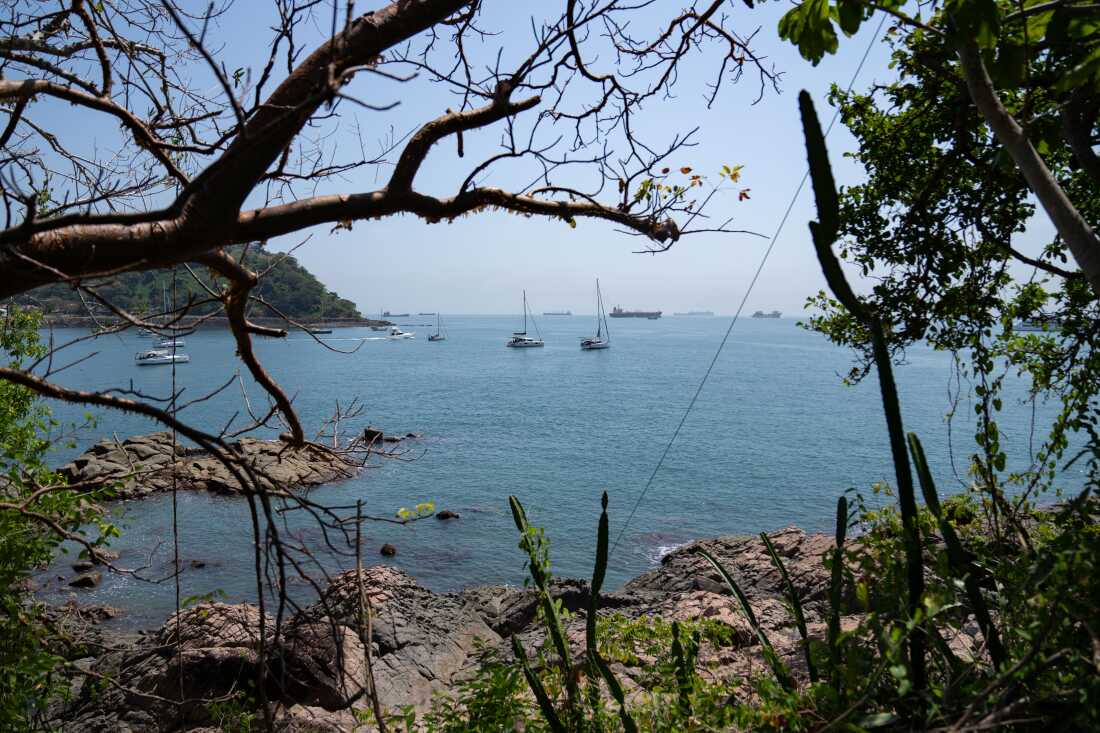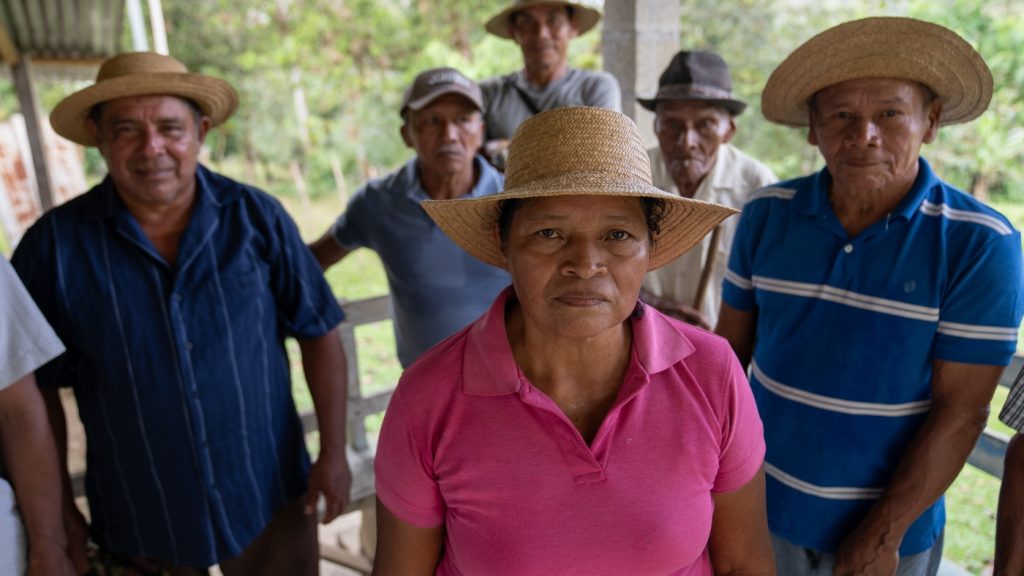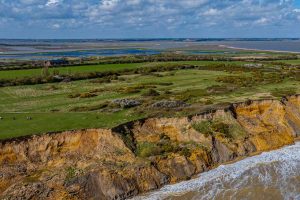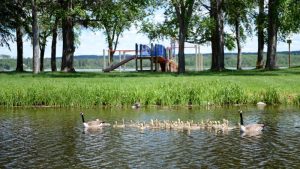
Digna Benite (center) calls her village of Limón de Chagres, a land made of love.
Tomas Ayuso for NPR
hide caption
toggle caption
Tomas Ayuso for NPR
LIMÓN DE CHAGRES, Panama — Digna Benite stands on the banks of the calm Río Indio and recalls playing in the water while her father fished.
“This river is my whole life,” Benite, 60, says through a translator.
Benite’s small village, made of simple homes and one paved road, depends on this river. It sits about 10 miles west of the edge of Lake Gatún, the enormous freshwater reservoir that feeds the mighty Panama Canal. Río Indio is crucial to the canal system.
And soon, Benite and thousands of others will be forced to relocate to make way for a new dam that would drown their homes. Last week, the Panama Canal Board of Directors approved plans to build a dam to solve what it says is a long-term water shortage problem. Construction is expected to begin in 2027.
The dam project will “meet the needs for the next 50-year horizon,” says John Langman, vice president of water projects at the Panama Canal Authority.
Panama is one of the rainiest countries in the world. Many thought the country would never run out of water. But in 2023, a drought caused by El Niño got so bad that water levels and canal traffic plummeted, reducing the number of ships passing through by more than a third.
More than 50 million gallons of freshwater are required to move a vessel through a series of locks.
All Things Considered recently visited Limón de Chagres and met with a few dozen people from neighboring communities. Many of the homes we walked past had signs in Spanish saying, ‘No to the reservoir.’

A sign outside of a home in Limón de Chagres, Panama. The sign says in Spanish, “For a green Panama, in respect of nature. No to the reservoirs.” The sign is in protest of a planned infrastructure project that would leave several farming villages underwater.
Tomas Ayuso for NPR
hide caption
toggle caption
Tomas Ayuso for NPR

A dugout vessel, known locally as a cayuco, serves to transport Digna Benite along the waterways of rural Panama.
Tomas Ayuso for NPR
hide caption
toggle caption
Tomas Ayuso for NPR
‘We are happy here’
Climate researcher Steve Paton, director of the Physical Monitoring Program at the Smithsonian Institution in Panama, says scientists have not found a clear connection between El Niño and climate change.
“There is no scientific evidence as yet that these years of low rainfall” are associated with climate change, but “some strange weather patterns are emerging,” he added. “I remember in 2016, which was the previous big El Niño event, we almost ran out of water. We came really, really close. The entire city of Panama came within like a few days of running out of water.”
Then the drought in 2023 happened. At the beginning of that year, “the lake was at the lowest point it [had] ever been for that time of year and very close to a historical low level,” Paton said.
He said the driest years in more than a century of record keeping have been recorded in the last decade.

Ships crossing the Panama Canal just outside Panama City, Panama.
Tomas Ayuso for NPR
hide caption
toggle caption
Tomas Ayuso for NPR

Steve Paton, director of the Physical Monitoring Program at the Smithsonian Institution in Panama, measures different changes in sunlight, rainfall and temperature.
Tomas Ayuso for NPR
hide caption
toggle caption
Tomas Ayuso for NPR
“We don’t know whether this is just an outlier, that it was just random — we just threw three double-sixes in a row — or whether it represents the canary in the coal mine where something really important has changed and we’re just at the beginning of seeing it,” Paton says.
That helps explain why Panama is looking for ways to increase the supply of freshwater.
“Right now, we are late by six years,” says Jorge Luis Quijano, a former administrator of the Panama Canal Authority, who supports the project.

A sample of crops and food harvested in Limón de Chagres, Panama.
Tomas Ayuso for NPR
hide caption
toggle caption
Tomas Ayuso for NPR

Olegario Cedeño, 38, holds plantains outside a church in Limón de Chagres, Panama. Cedeño is among several dozen community members who are rallying against the planned construction of the Río Indio dam project.
Tomas Ayuso for NPR
hide caption
toggle caption
Tomas Ayuso for NPR
The new dam would flood the basin — where people like Benite live — and produce a reservoir. The water from the reservoir would flow back into Lake Gatún and be used for the canal. In a recent news release, the Panama Canal Authority says the project would also “guarantee water supply for over 50 percent of the country’s population.”
But it will come at a cost to the people living in the area. Langman estimates that more than 2,000 people will be displaced.
“For some people who have been there for generations, it will create hardships, but we intend to be with them all along,” Langman added. “And at the end, we do expect them to be better off.”
Quijano says some of the affected communities live in areas with no electricity or potable water. The canal authority has promised a relocation package that includes “compensation, resettlement, and support for families and property owners who may be affected by the project,” according to the news release.
“We’re going to make sure that we relocate them to a place where they can continue with their life and probably improve on that,” Quijano says. “There are many things that are positive for that community, which they don’t have today.”
But people living in Limón de Chagres dispute that rationale.

Alejandrina Muñoz (left) and her 3-year-old daughter, Cleidis, at their home in Limón de Chagres, Panama. Muñoz says she has everything she needs, including electricity and water.
Tomas Ayuso for NPR
hide caption
toggle caption
Tomas Ayuso for NPR

Alejandrina Muñoz’s 3-year-old daughter, Cleidis, at her home in Limón de Chagres, Panama.
Tomas Ayuso
hide caption
toggle caption
Tomas Ayuso
Alejandrina Muñoz, another villager here, says she has everything she needs, including electricity and water.
“We are happy here. We have water, we have electricity, we have solar panels,” she says through a translator as she washes dishes with spring water that flows through her faucet.

Farmers discuss the future of their village, Limón de Chagres.
Tomas Ayuso for NPR
hide caption
toggle caption
Tomas Ayuso for NPR

Residents from Limón de Chagres and nearby communities discuss the future of their home. The villagers argue that the proposed Río Indio dam project would destroy countless acres of fertile ground and leave many families destitute.
Tomas Ayuso for NPR
hide caption
toggle caption
Tomas Ayuso for NPR
Muñoz organized a group of people from surrounding communities who wanted to share their thoughts about being uprooted from their homes.
We asked the group whether anyone feels tempted by the life of luxury that the Panama Canal Authority promises.
A handful of people shout, “No!” They won’t accept the government’s relocation package.
“What are we going to eat in that house if we have nothing to produce ourselves?” asks 63-year-old Claudino Dominguez. He says life is about more than having a fancy house.

Near Limón de Chagres, trees lean over Río Indio — a waterway that connects communities and is crucial to the Panama Canal system.
Tomas Ayuso for NPR
hide caption
toggle caption
Tomas Ayuso for NPR
If anyone here supports the government proposal, we couldn’t find them.
At the end of the community gathering, villagers stood up and chanted in Spanish, “Our river is not for sale, we will defend it!”
They say their land is not for sale, but the Panama Canal Authority is still planning to move forward with the project.








